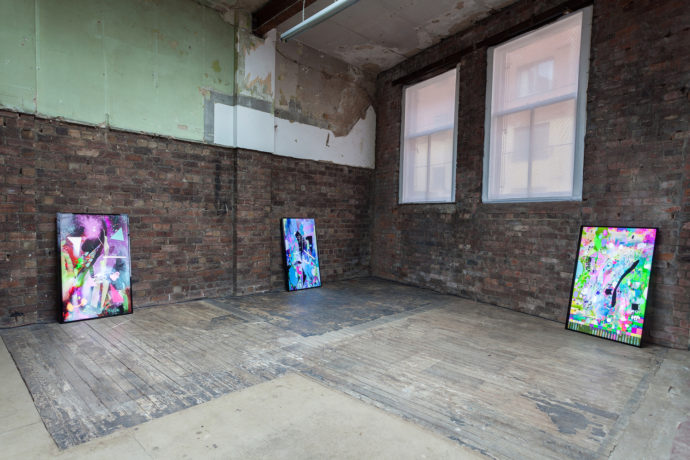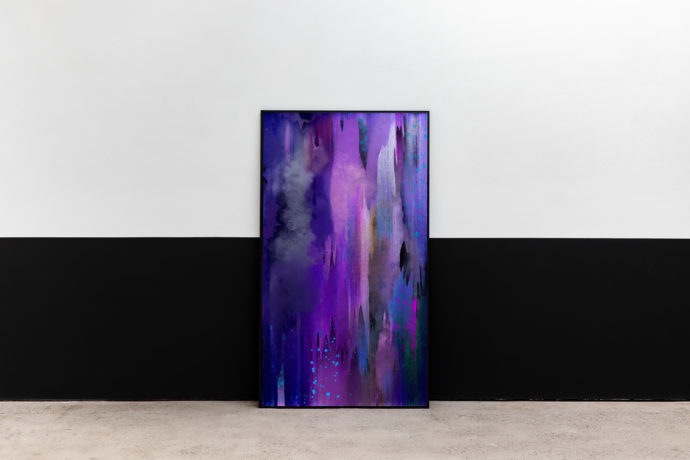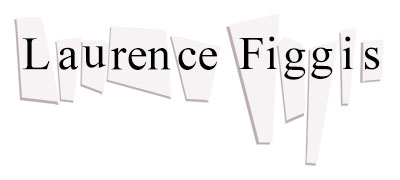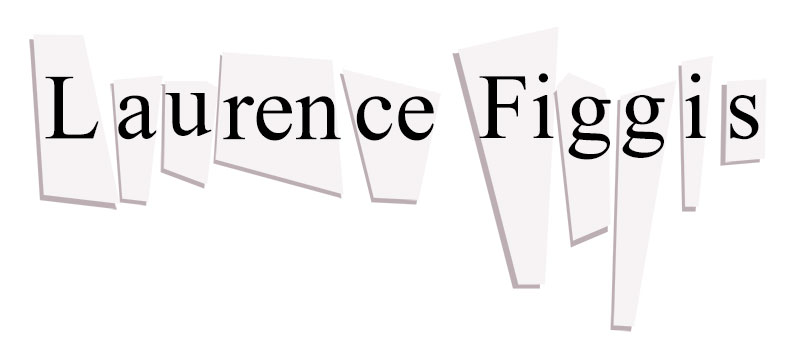Why are the paintings (not) televised? Some thoughts on the work of Gregor Wright
In the 2018 exhibition ‘Magic Stuff’, Gregor Wright showed a series of what he called ‘screen-based paintings’, digital works on UHD screens; abstract in appearance, and (implicitly) animate in nature. In the past, Gregor’s work has incorporated painting, drawing, sculpture (along with activities such as making fanzines and printing T-shirts), but the screens are prominent in the current body of work—and, as such, will be the focus of these reflections.
Though I don’t have a detailed knowledge of the algorithmic processes that were used to make them, I have a strong intuitive feeling they were not made to illuminate our conceptual understanding of “the digital” in contemporary life (nor the effect of digital platforms on painting as a medium). Rather, as the title of the 2018 show suggests, they were made to bring about an autonomous experience of magic.
Magic in its most intellectually dynamic form, is a moment when ‘consciousness blinks’, as the chaos magician Grant Morison has written. In his guide to activating a sigil (the symbolic condensation of a magical desire or intent), Morison writes of an ‘abyssal crack in perception’ such as that experienced during an abstracted or delirious mental state.
I’m intrigued by this gap in consciousness, as it might be experienced in response to Gregor’s paintings. The short reflections which follow are an attempt to describe that feeling of petrification.

Installation view, Gregor Wright, ‘Magic Stuff’, 2018, © The Modern Institute/ Toby Webster Ltd.
Why are the paintings (not) looked at?
When the screen-based paintings were shown in the Brick Space at the Modern Institute in 2018, they were not encountered as ‘pictures’, but placed directly on the floor, leaning against the brick walls. When the viewer first noticed them, they were slightly out of view and seemed to function like stained glass windows, as bright spots of colour in a dim, cavernous vault. To engage with them you had to look awry, to stare at the margins of the room. Even then, they seemed to resist the viewer’s gaze. The compositions were densely congealed with shapes and textures; little (or no) trace of representational imagery; and no meaningful reference to the history of abstract painting. Their palettes were high-octane; erring towards cool or synthetic colours (magentas, violets, blues, acidic greens, caustic yellows) shot through with black fissures, adding chill to their density. The sense that they were somehow stuck or ‘jammed’ proved to be correct; it was only after being stared at continuously that they revealed themselves to be in (very slow) motion.
The same verb (‘regarder’) in French means both to ‘look at’ and ‘to watch’. Likewise, in Italian, the word ‘guardare’ is used for both activities. Both incorporate the protective— authoritarian—verb ‘guard’ (in English). We also ‘watch’ in the sense of ‘to guard’; but we differentiate these modes of looking. There is no ambiguous confusion of attitude when we speak of ‘looking at a painting’ or ‘watching television’. We do not ‘watch’ the painting (unless we are afraid it might be stolen—or fall down).
The ‘watched’ thing, by implication, moves—or might move. It might be alive or (seem to) have its own agency. We are (by implication) alert, nervous, anticipatory when ‘watching’ something; serene, contemplative, calm when ‘looking at’, for example, a painting.
Why are the screens (not) watched?
When I visit Gregor in his studio, prior to writing these reflections, I ask him about the screens on which the paintings will be displayed. Are they essentially televisions?
Screens have multiple uses nowadays—and hardly resemble the clumsy boxes, the hulking bits of furniture on which we used to ‘watch’ television.
Gregor remarks that the manufacturer has branded these particular screens, ‘frames’. I wonder if the marketers of these screens read high modernist theory and understand that ‘frames’ are ideological constructs as well as functional devices (it does seem appropriate to be viewing these paintings—even digital paintings— in frames).
But, as I think about the screens, and their day-to-day function, I become aware that I’m conceiving them as objects, that I have become distracted from the paintings themselves. I wonder how this relates to the semantics of ‘watching’ and ‘looking’ mentioned above.
When we say, ‘look at the television’, are we not acknowledging the hardware itself as a material object—as furniture? Whereas, when we watch television, are we not receiving the information it confers upon us? The word ‘watch’ (an active verb) is contrary to this notion of passive consumption. ‘Watch’ is not a term by which we readily understand that television is doing something to us. We have no verb for looking at something, in such a way that torpifies, petrifies, perhaps even violates the bearer of the look. A word for looking that is like being force-fed, penetrated, frozen.
In Gregor Wright’s screen paintings, this distinction (the distinction between ‘watching’ and ‘looking’) is sometimes very subtle.
Remember ‘Test Card F’ (in the days when television went to sleep)? The long moments I spent trying to make Carole Hersee and her clown Bubbles move by sheer force of will; the torment I felt— awaiting whatever fluff would be transmitted in the early hours of a Saturday morning. I felt the same when Gregor’s paintings first began to move; they changed so slowly as to arouse a nagging impatience.
The founder of the surrealist movement, André Breton once wrote that ‘there can be no beauty—convulsive beauty—except at the price of the affirmation of the reciprocal relationship that joins an object in movement to the same object in repose.’ He compared this phenomenon to a process of dissemblance in nature, when, for example, one organism mimics another, or when substances, such as rock crystals, change their physical state.
This quality is also to be found in Gregor’s screen-based paintings. For all their hard-edged technological appearance, they have the slow, mysterious ambience of geological forms, of pulsing, organic entities. In more recent versions of these screens, their ‘animate’ qualities are obvious—they move more quickly; but the sense that they are stuck or frozen remains.
As Gregor tried to explain to me, they were made using a range of apps designed to glitch images on purpose (the transitions, recorded in real time, were subject to further manipulation in film-editing software). With my lack of specialist knowledge, I struggle to comprehend these mysteries; but I’m enlightened enough to grasp the essential conceit— that the algorithms have been deployed in a manner akin to the disruptive logic of hacking. The resulting images appear shattered or torn, which seems to give them an ugly sort of tangibility.

Gregor Wright, Fantasy Imaginary Cave Fantasy, 2022, screen work, 5 minutes loop, 4K screen, 167.6 x 96.3 cm, © The Modern Institute / Toby Webster Ltd.
Why are the colours (not) synthetic?
The screen-based paintings remind me of some old drawings by Gregor, that I can’t find online, in which marker pens had run dry on the page, creating frayed lines like charcoal marks. Like the screen paintings, his drawings might be described as icily expressionistic— cold in temperature, magic in feeling.
This mood has something to do with the prevalence of synthetic colours, mentioned above—as opposed to colours which suggest a natural landscape. Like Gregor’s works on canvas and paper, the screen-paintings recall marker pens, highlighters: tools made of plastic and solvent chemicals. I find this colour-scheme perversely romantic; equivalent to the nostalgia that some people now express for decades-old science-fiction films— images of the decay of modernity generated in the distant past.
What does it mean to feel nostalgic for the (dystopian) future? The screens do not answer this question (nor do they explicitly pose it—they are too mute, too inert, to ask anything). I’m nonetheless intrigued by the notion of a rapturous feeling (an expressionism) that arises from this coldly technocratic field. On the one hand, we have absolute artifice (the solvent colours, impervious reflective screens); on the other a sort of hysteria suggested in the convulsive freezing (and trembling) of brush marks and pixels that seem to be animate.
I wonder if these are the ideal conditions for magic.
It is my understanding that the various apps used to generate the paintings have the potential to modify images radically and without limit. This infinity, mentally expansive on the one hand, is also oppressive existentially; as suggested by Gregor’s allusion to another expansive/claustrophobic method: the endlessly mirrored or repeated gesture or sign.
I wonder if this bleak existential feeling, underwritten with a feeling of synthetic sadness, might be considered equivalent to the ‘gap in consciousness’ evoked by Chaos Magic —the space where a sigil can be launched.
Is the algorithmic technology merely the raw material through which to affect these magic spells? As such, do the screen paintings have a much deeper (and more energising) significance than a mere ‘comment’ on digital culture? Do they reach back to older (secular) occult rituals and processes, prior to the technologies that now shape, expand, and limit our spiritual lives?
Works cited:
André Breton, ‘Beauty Will be Convulsive,’ 1934.
Grant Morrison, “Pop Magic!” 2008

